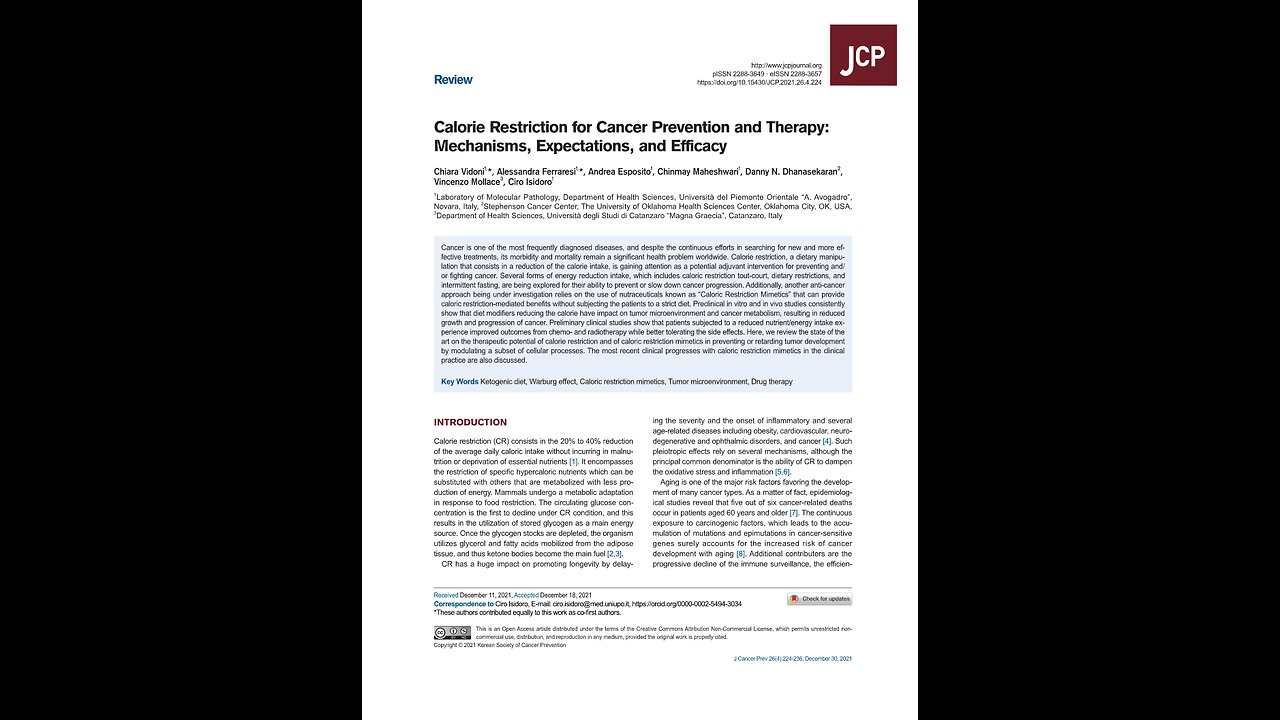Premium Only Content

Calorie Restriction for Cancer Prevention. Chiara Vidoni, A Puke(TM) Audiopaper.
https://www.ncbi.nlm.nih.gov/pmc/articles/PMC8749320/pdf/jcp-26-4-224.pdf
https://rumble.com/v3t4yzj-index-of-science.-music-by-dan-vasc.html
Calorie Restriction for Cancer Prevention and Therapy: Mechanisms, Expectations, and Efficacy.
An average quality review by Chiara Vidoni, Laboratory of Molecular Pathology, University oriental pasta, Novara, Italy.
Cancer is one of the most frequently diagnosed diseases, and despite the continuous efforts in searching for new and more effective treatments, its morbidity and mortality remain a significant health problem worldwide. Calorie restriction, a dietary manipulation that consists in a reduction of calorie intake, is gaining attention as a potential adjuvant intervention for preventing and, or fighting cancer. Several forms of energy reduction intake, which include caloric restriction tout-court, dietary restrictions, and intermittent fasting, are being explored for their ability to prevent or slow cancer progression. Additional anti-cancer approaches under investigation rely on the use of nutraceuticals known as “Caloric Restriction Mimetics” that can provide caloric restriction-mediated benefits without subjecting the patients to a strict diet.
Preclinical in vitro and in vivo studies consistently show that diet modifiers reducing caloric intake have impact on tumor microenvironment and cancer metabolism, resulting in reduced growth and progression of cancer. Preliminary clinical studies show that patients subjected to a reduced nutrient, energy intake experience improved outcomes from chemo and radiotherapy while better tolerating the side effects. Here, we review the state of the art on the therapeutic potential of calorie restriction and of caloric restriction mimetics in preventing or retarding tumor development by modulating a subset of cellular processes. The most recent clinical progresses with caloric restriction mimetics in the clinical practice are also discussed.
Key Words.
Ketogenic diet, Warburg effect, Caloric restriction mimetics, Tumor microenvironment, Drug therapy.
Introduction.
Calorie restriction (CR) consists of a 20 to 40 percent reduction of the average daily caloric intake without incurring malnutrition or deprivation of essential nutrients. It encompasses the restriction of specific hyper caloric nutrients, which can be substituted with others, that are metabolized with less production of energy. Mammals undergo a metabolic adaptation in response to food restriction. The circulating glucose concentration is the first biomarker to decline under CR condition, which results in the utilization of stored glycogen as a main energy source. Once the glycogen stocks are depleted, the organism utilizes glycerol and fatty acids mobilized from the adipose tissue, and thus ketone bodies become the main fuel. CR has a huge impact on promoting longevity by delaying the severity and the onset of inflammatory and several age-related diseases including obesity, cardiovascular, neurodegenerative and ophthalmic disorders, and cancer. Such pleiotropic effects rely on several mechanisms, although the principal common denominator is the ability of CR to dampen the oxidative stress and inflammation.
Aging is one of the major risk factors favoring the development of many cancer types. Epidemiological studies reveal that five out of six cancer-related deaths occur in patients aged 60 years and older. The continuous exposure to carcinogenic factors, which leads to the accumulation of mutations and epimutations in cancer-sensitive genes surely accounts for the increased risk of cancer development with aging.
Additional contributors are:
The progressive decline of the immune surveillance, the efficiency of DNA repair and of autophagy.
The dysregulation of the inflammatory process.
The increased production of reactive oxygen species (ROS).
Increased levels of circulating insulin and
Many other hormones promoting cell growth, and other factors.
CR may arrest and slow-down age-related decline of cellular protective systems, especially by improving autophagy and dampening inflammation and ROS production, as well as reducing circulating growth hormones, and this could result in reduced risk of cancer.
Preclinical and preliminary clinical data support the view that reducing calorie intake as well as periodic fasting or dietary restriction, in which intake of macronutrients is limited with no reduction in total calories, has the potential to prevent and treat cancer.
Typically, in a CR or dietary restriction regimen, carbohydrates, the main source of energy in the regular diet, are reduced and replaced partially or nearly completely, as in the ketogenic diet, by fat. Indeed, reducing sugar intake seems to be a good strategy to fight cancer, given that cancer cells use glucose as the main fuel. Likewise providing ketones as an alternative energy source may limit cancer growth because cancer cells do not efficiently harness ketones for their anabolism.
Here, we describe the cellular and molecular mechanisms underlying the pathophysiological effects of calorie and nutrient restrictions and review the scientific proofs of their beneficial effects in preventing cancer onset and progression as well as in improving the anti-cancer therapeutic effects. We also discuss the anti-cancer effects of drugs and nutraceuticals with proven caloric restriction mimetic (CRM) activity.
Finally, we present the clinical trials currently investigating the efficacy of caloric restriction dietary regimens as an adjuvant therapy in anti-tumor treatment.
Molecular and cellular effects of calorie restriction at a glance.
For a long time, the beneficial impact of CR was regarded merely as the result of the passive effect of nutrient limitation and of a slow metabolism. It is now recognized that the organismal effects of CR are actively regulated processes aiming to reduce oxidative stress, and that CR triggers a robust defense program involving multiple metabolic pathways in which nutrient sensors are centrally positioned in such regulation. However, the effects of CR depend on multiple factors such as individual characteristics and the dose and timing of CR.
The metabolic adaptations to CR include:
(1) A decrease in growth factors and production of anabolic hormones.
(2) An upregulation of anti-oxidant systems, which in turn decreases free radical-induced DNA damage. (3) A downregulation of pro-inflammatory cytokines and an increase in circulating levels of corticosteroids, ghrelin and adiponectin, collectively resulting in the reduction of inflammation, and
(4) A delay of aging-associated deterioration of host immune surveillance.
More in detail, many of the benefits exerted by CR are associated with the upregulation of genes promoting DNA repair, for example, genes belonging to the base excision repair pathway, the removal of damaged cells through apoptosis, autophagy, stress response and anti-oxidant defense, in parallel with the downregulation of pro-inflammatory genes and of energy metabolism pathways.
Particularly, autophagy represents the primary stress response to calorie and nutrient restrictions. This process is in fact regulated mainly by two pathways that sense the lack of energy sources and ATP production in the cell, via the AMP-activated kinase (AMPK) and hexokinase 2 (HK2) mTOR complex 1 (mTORC1) pathway, and the lack of growth factors and of amino acids, via the protein kinase B (AKT)-mTORC1 pathway, Figure 1.
Autophagy, herewith referring to macro autophagy, consists in the p62, SQSTM1-mediated entrapment of cellular components, such as protein aggregates, membranes, and mitochondria (mitophagy) along with portions of cytoplasm, within a double-membrane organelle named the auto phagosome that upon fusion with the lysosome determines the degradation of those components. This process is regulated by several signaling pathways and autophagy-related (ATG) proteins that also include oncogene products and tumor suppressors, which explains why this process is dysregulated in cancer. Under metabolic stress conditions such as those determined by the lack of nutrients, amino acids, glucose, and of hormones and growth factors, autophagy is upregulated to provide energy and substrates from degradation of redundant cell components.
As illustrated in Figure 1:
(1) Amino acids, especially, methionine, leucine and arginine, directly activate mTORC1, the mechanistic target of rapamycin complex 1, which then inhibits the axis Unc-51 like autophagy activating kinase 1 complex 1 (ULKC1)-phosphatidylinositol 3-kinase catalytic subunit type 3 (PI3KC3)-BECLIN-1 that positively triggers autophagy.
(2) The presence of growth factors and hormones elicits the activation of mTORC1 via the PI3KC1-AKT pathway thus resulting also in inhibition of autophagy.
(3) Soon after entry, glucose is phosphorylated to glucose-6-phosphate (G6P) by HK2, and this prevents HK2 from interacting and inhibiting mTORC1, and this results in inhibition of autophagy as well.
Therefore, autophagy is maximally induced when all these nutrients and growth factors are absent in the tumor microenvironment (TME), as for instance that occurs during starvation. Upregulation of autophagy in cancer cells may have several beneficial outcomes in terms of improved DNA repair efficiency, improved TME, reduced growth and migration, invasive ability.
Calorie restriction and cancer progression.
From a molecular point of view, several signaling pathways collaborate and cross-talk to control carcinogenesis under CR conditions.
To date, the major effectors known to be responsible for the CR-mediated anti-cancer activity include insulin-like growth factor-1 (IGF-1), phosphatidylinositol-3-kinase, PI3K, AKT, mTOR, the Sirtuin family proteins, Aldolase A (ALDOA), DNA-dependent protein kinase, DNA-PK, p53, NF-kappa B and AMPK signaling pathways. However, further studies aiming to characterize the molecular mechanisms by which CR mediates its cancer inhibitory effects are essential for development of new drugs and therapeutic regimens to prevent tumor initiation and, or interrupt tumor promotion and progression. CR can also modulate epigenetic changes, particularly DNA methylation, histone modifications, chromatin remodeling and generation of microRNA, which regulate the expression of genes involved in those processes responsible for CR anti-cancer activity.
Notably, CR has been shown to have a wide impact not only on cancer cells but even on TME by allowing enhanced drug delivery, by decreasing the availability of substrate and growth factors for cancer cells, and by reducing inflammation.
Tumor vascularization represents one of the most crucial steps in cancer progression by ensuring nutrients, soluble factors and oxygen to reach the tumor mass. CR has been capable of counteracting this aspect by hampering the secretion of pro-angiogenic factors such as VEGF, factor eight, interleukin-6, IL-6, TNF-alpha, plasminogen activator inhibitor-1, PAI-1, and others. Consequently, tumor neo-vascularization was delayed or even arrested as demonstrated by the reduction in the size, number and density of blood vessels in the CR-fed mice in comparison with the trends observed in ad libitum-fed ones.
Additionally, CR can shape the tumor immune microenvironment by specifically decreasing the number of tumor associated macrophages, increasing the formation of a reservoir of CD8 plus cytotoxic T cells and memory T cells while negatively modulating immunosuppressive Treg cells’ activity and immunosuppressive cytokine levels.
Other pivotal players in the TME are the cancer-associated fibroblasts. CAF’s, that by releasing onco metabolites, growth factors, inflammatory cytokines and proteolytic enzymes cooperate in the establishment of a malignant liaison between the stroma and cancer parenchymal cells. The evolution of tumor fibrosis, that originates from cancerous lesions, causes an excessive deposition of extracellular matrix and, as a consequence, damaged epithelial cells produce a large amount of pro-inflammatory and pro-fibrotic cytokines, leading to more and more aggravated deposition of collagen and fibrotic tissue. In this context, CR can elicit an anti-fibrotic effect by downregulating TGF-Beta signaling, that normally promotes the phenotypic conversion of normal fibroblasts in CAFs. In this respect, a highly dense and viscous stroma prevents the cells of the immune system to target the tumor, thus making it much more resistant. By preventing fibrosis, CR may facilitate the interaction of immune cells with cancer.
The remodeling of the TME mediated by CR is schematically represented in Figure 2.
Benefits of caloric restriction in anti-cancer therapy.
To date, chemotherapy is one of the main therapeutic strategies for the treatment of several malignancies. However, this approach causes many side effects, such as cardio, neuro, haematological toxicity, nausea, gastrointestinal symptoms, fatigue, weakness, hair loss and stomatitis, that can negatively affect the cancer patients’ quality of life and cause discontinuity of the therapy. Disappointingly, most of the drugs used to manage the symptoms of toxicities may themselves have significant adverse effects.
Although most of the available studies regarding CR in anti-cancer therapy are still in the pre-clinical phase, CR appears to be a promising approach to modulate the chemotherapy induced side effects while enhancing the efficacy of the treatment. Reduction of adverse effects would improve the quality of life and potentially reduce the costs of hospitalization as well as the use of drugs, for example anti-emetics, antibiotics.
In detail, CR can induce healthy cells to invest their energy in reparation and maintenance pathways rather than cell proliferation. This effect promotes an increased resistance of normal cells to chemotherapeutic drugs known as “differential stress resistance”. On the other hand, cancer cells bearing mutations in oncogenes, for example, IGF-1R, Ras, AKT and and the mTOR pathways, that cause constitutive activation of proliferation pathways in external growth factor-independent manner, and onco suppressor genes, for example, p53, p16 and Rb, that cause insensitivity to growth-inhibitory signals, are not prone to adapt to fasting conditions and continue to proliferate at a high rate.
This results in an enhanced sensitization of cancer cells to chemotherapy-induced apoptosis while protecting normal cells from such effect, leading to the so called “differential stress sensitization”.
Several reports indicate that fasting potently triggers autophagy, both in normal cells and cancer cells, to recycle critical components and produce energy. The upregulation induction of autophagy before chemotherapy may protect benign cells by providing an alternative mechanism to remove damaged macromolecules and organelles, particularly when the proteasomal degradation pathway is saturated. However, autophagy may also play a pro-survival role in some cancer cells. On the other hand, over activation of autophagy may lead to what is referred to as autophagy-associated cell death. Given the complex role of autophagy in tumor biology, which is strictly dependent on the context and the stage of malignancy, further studies are needed to dissect the balance between benefits and side effects related to CR-induced upregulation of autophagy.
Even though CR displays numerous benefits in anti-cancer therapy, the real applicability of fasting regimens in the clinical practice could be limited to a small subset of cancer patients, as some potential risks may be associated with this approach, such as malnutrition, cachexia and sarcopenia, that are strongly associated with chemotherapy-related toxicity, reduced response to cancer treatment, low quality of life and a worse overall prognosis. Another concern is related to the anti-inflammatory effect of CR that could be disadvantageous for those patients that experience immunodeficiency due to cancer progression and, or as a consequence of repeated chemotherapy treatments. Therefore, more tolerable adjuvant regimens should be developed. In this perspective, fasting-mimicking dietary interventions as well as CRM’s, that will be discussed more in detail in the next section, may represent a more feasible therapeutic approach to circumvent these limitations. Overall, the global impact of CR and CRM’s on the anti-cancer therapy is illustrated in Figure 3.
Caloric restriction Mimetics.
An alternative therapeutic strategy that extends life expectancy and improves health markers, while reducing the development of several age-related diseases, including cancer, involves the use of the pharmacological group of compounds known as CRM’s. These compounds act, either through direct interaction with signaling molecules or via epigenetic mechanisms, those pathways that are triggered when energy intake is reduced, yet in the presence of adequate nutrition.
Many CRM’s are bioactive food components able to elicit anti-proliferative, pro-apoptotic and anti-metastatic effects, avoiding a fasting regimen that could not be tolerated by the cancer patient. The family of polyphenol substances are all a good source of potential CRM’s, since they have a wide range of biological activities, including anti-oxidant, anti inflammatory, anti-carcinogenic and epigenetic modulation activities. They include phenolic acids and derivatives, flavonoids, stilbenes, and coumarins. CRM’s modulate energy and nutrient-sensing pathway impinging on many biological mechanisms, including activation of autophagy, enhancement of insulin sensitivity, inhibition of oxidative stress and inflammation, and modulation of glucose metabolism. The molecular targets of CR involve sirtuins, acetyl-CoA, activated AMP protein kinase, insulin, and mTOR.
CRM’s in clinical practice.
We will focus on the beneficial effects of the most relevant and promising CRM’s, summarized in Table 1, both FDA approved and not yet approved, and will illustrate their potential clinical applications as new effective anti-cancer strategies.
Resveratrol.
Resveratrol, 3, 5, 4 tri hydroxyl stilbene, RV, is a natural stilbene compound present in vegetables and fruits in general, but especially abundant in grapes. RV acts as a CRM as well as a protein restriction mimetic. RV has pleiotropic beneficial effects not limited to cancer, but even to metabolic syndromes and neurodegenerative diseases. The tumor suppressive effects of RV on manifestation of malignant phenotype of cancer cells involve the repression of the drug resistance and metastatic ability, counteracting hypoxia, inhibition of inflammation and oxidative stress, and so on. In details, RV reverts cell invasion, which is promoted by high generation of ROS through activation of the Hedgehog pathway.
Cumulative studies have illustrated the impressive anti-inflammatory properties of RV. In vivo experiments showed that mice treated with RV exhibit low levels of pro-inflammatory cytokines like TNF-alpha, IL-6, IL-1 and IL-8, typical biomarkers of the inflammation. Further, RV increases the number of T cells, specifically natural killer and CD8+ T cytotoxic cells, implementing anti-cancer immune surveillance. Another anti-inflammatory property mediated by RV is the suppression of the NF-kappa B pathway and of TNF alpha induced cancer cell migration and invasion. Additionally, RV can block tumor development by targeting cytochrome p-450 enzymes able to activate pro-carcinogenesis factors.
Furthermore, RV positively impacts to expand lifespan as an epigenetic modulator, specifically through the activation of sirtuin deacetylases (SIRT1) and autophagy mediated via AMPK pathway. Besides limiting glucose uptake and reverting the inflammatory phenotype of CAF’s, RV is a potent autophagy inducer. Many preclinical and clinical trials in different types of cancer, for example, breast, colon, and prostate, support its anti-cancer effects.
Although RV has many anti-carcinogenic properties, its poor bioavailability limits its clinical use. Nevertheless, there is evidence that RV, either alone or in combination with other agents, is active. Therefore, an alternative strategy is to modify the RV structure for improving its bioavailability and reducing its toxicity. Nowadays, it is clear that RV is a fascinating adjunctive cancer treatment when associated with standard chemotherapeutic agents, but there is still the necessity to define the optimal conditions to ameliorate the delivery and the efficiency.
Table 1. Overview of the ongoing clinical trials with caloric restriction mimetics, CRM’s.
The table reports the CRM’s that are employed in ongoing clinical trials in cancer patients. The table elaborated with data extracted from the clinical trials dot gov site.
Curcumin.
Curcumin is a polyphenol compound, FDA-approved, for CRM properties that has caught the attention of many researchers.
It is the main bioactive compound isolated from the rhizomes of Curcuma longa (Turmeric). Several investigations have revealed the multitude of biochemical and biological activities of curcumin with therapeutic potential, including anti-inflammatory, anti-oxidant, anti-cancer and anti androgenic effects.
Particularly remarkable is its anti-cancer activity exerted through induction of apoptosis, inhibition of cell proliferation and of tumor invasion, and downregulation of NF-kappa B, COX-2, and STAT3. Furthermore, curcumin counteracts the Warburg effect, meaning, the aerobic glycolysis occurring in cancer cells) via the suppression of pyruvate kinase M2 (PKM2). Additionally, curcumin suppresses the PI3K, Akt, mTOR pathway (by decreasing Akt and mTOR phosphorylation in parallel with PTEN upregulation) thus promoting cell death in cancer cells.
Of note, curcumin also abrogates CAF-induced aggressiveness of cancer cells through the inhibition of the mTOR, HIF-1 alpha signaling. The anti-carcinogenic property of curcumin is well-documented in several types of cancer, which makes it a promising co-adjuvant agent in cancer therapy.
Metformin.
Metformin (dimethylbiguanide hydrochloride) is a derivative of natural biguanidines isolated from the French lilac, Galega officinalis, a plant used for the treatment of type 2 diabetes and metabolic syndrome since the nineteen sixties. Metformin administration is not yet certified as adjuvant of anti-cancer therapy.
Mechanistically, it suppresses hepatic gluconeogenesis and decreases insulin levels thus acting as a hypoglycemic drug. This effect is attributed to the activation of energy sensor AMPK via the repression of the mitochondrial electron transport chain complex One, thus leading to the inhibition of mTORC1. For this reason, this molecule is associated with prolonged lifespan, promotion of autophagy, and suppression of oxidative stress and inflammation. As epigenetic modulator, metformin inhibits class two HDAC’s, while stimulates class three HDAC SIRT1 activity.
Another important physiological action of metformin involves the immune system. This compound can modulate lymphocyte differentiation during the aging process, promoting CD8 plus memory T cell differentiation, and simultaneously reducing the expression of several pro-inflammatory cytokines. The latter aspect could represent a relevant opportunity to counteract the development of immune evasion within the TME.
Taken together, metformin has crucial functions in modulating energy metabolism, while its capacity in retarding or contrasting cancer progression is less addressed. In addition, recent clinical trials are also testing its anti-cancer activity, especially in colon, breast, ovarian, prostate and lung tumors, however, further investigations are needed.
Spermidine.
Spermidine is a polyamine naturally found in a variety of foods, including wheat germ, soybean, mushrooms, and mature cheese. Further, it is produced by the intestinal microbiota.
The effects of this polyamine include extending the lifespan in many model organisms, an effect correlated to induction of autophagy and inhibition of acetyltransferase activity. Moreover, spermidine stimulates AMPK, while it limits the mTORC1 activity. Predominantly, spermidine is able to stimulate mitophagy in both in vitro and in vivo assays, sustaining its capability to slow down the aging process and to sustain tissue renewal. Another molecular mechanism underlying the cancer preventive action of spermidine involves the competition of spermidine with acetyl-CoA for EP300 binding which may contribute to a reduced cancer-related mortality in patients. The inhibition of acetyl transferase EP300 triggers autophagy by the deacetylation of many ATG genes. Furthermore, spermidine, through autophagy activation, can also improve anti-cancer immune surveillance. To explore and support the spermidine administration as adjuvant anti cancer treatment, more clinical trials are needed. Hydroxycitrate Hydroxycitrate (HC) or hydroxycitric acid (HCA) is a CRM present in tropical plants as Garcinia cambogia and Hibiscus sabdariffa. It is widely used as a weight-loss drug in obese patients, but it also possesses anti-cancer activity.
A HC’s peculiarity is its ability to block acetyl-CoA synthesis by inhibiting the enzyme ATP citrate lyase, thus representing an innovative approach to target cancer metabolism.
This compound enhances autophagy flux, since it reduces lysine acetylation of cellular proteins. It has been found that the treatment of HC promotes the depletion of regulatory T cells from the tumor, improving immunosuppressive ability and counteracting lung cancer progression. Based on these premises, further synthetic agents, namely acetyl-CoA inhibitors, have been proposed as CRM’s: perhexiline maleate is now used in the clinical practice as an anti-anginal agent with cardioprotective and anti-tumor effects.
Halofuginone.
Halofuginone (HF) is a synthetic derivative of febrifugine, a natural quinazolinone alkaloid found in the plant Dichroa febrifuga Lour. It is known for its anti-protozoal activity and it is used as an anti-malarial agent in traditional Chinese medicine. Its activity includes inducing amino acid starvation response (AAR) in cancer cells in parallel with the concomitant activation of autophagy. Accordingly, the molecular explanation for its action is that HF inactivates mTORC1 by causing its detachment from the lysosomes and its degradation in proteasome, while promoting the nuclear translocation of the ATG transcription factor TFEB.
Furthermore, HF shows its anti-inflammatory propriety by inhibiting the differentiation of inflammatory Th17 cells, an effect clearly linked to induction of AAR. More significantly, HF is a well-known inhibitor of collagen type I synthesis due to the repression of the TGF-Beta pathway. HF also prevents keloid fibrosis by reducing the deposition of ECM and decreasing the proliferation and migration of TGF-Beta activated myofibroblasts. In agreement with this, HF has found clinical application as a therapeutic agent in fibrotic disease and in some types of malignancies, such as lung and bladder cancer. In this respect, further clinical trials are needed to validate the anti-fibrotic property of HF in a wide range of tumors.
Rapamycin.
Rapamycin, also known as sirolimus, is a macrolide compound that was first isolated in 1975 from the bacterium Streptomyces hygroscopicus, found in the soil of Easter Island. Rapamycin is the most promising CRM with an anti-cancer activity, and its efficacy has been addressed in various clinical trials.
Its molecular mechanism entails the inhibition of mTOR, a major regulator of cell proliferation and protein synthesis, by binding the protein FKBP12. Since rapamycin is an inhibitor of mTOR, this CRM promotes autophagy.
Consequently, sirolimus provokes the deregulation of mTOR downstream effectors resulting in a prolonged lifespan and in a healthier metabolism.
Additionally, this macrolide mediates immunosuppressive effects by controlling survival and proliferation of regulatory T-cells. Because of its side effects, including risk of cataracts, insulin-resistance and increased infections, the search for analogues of rapamycin, called rapalogs, occurred, which resulted for example, in NVP-BEZ235, OSI-027, and RapaLink 1. Everolimus, which belongs to the first-generation of rapalogs, was certified for the treatment of hormone receptor-positive, HER2, neu-negative advanced breast cancer, whereas temsirolimus, first-generation drug, was identified as a therapeutic agent in metastatic renal cell carcinoma.
Currently the anti-cancer activity of rapamycin and rapalogs is under investigation in several clinical trials, opening several possibilities for innovative anti-cancer treatments.
To sum up, see Table 1, it is well established that CRM’s can mimic the actions of CR, or rather delay aging and extend the patients longevity in parallel with improvement of physiological function and the reduction of the risk of many chronic diseases. This results in the avoidance of many side effects that occur with CR, together with better patient compliance. Nevertheless, even CRM’s-based therapeutic approaches show some limitations. For instance, many of them have not been investigated in a sufficient number of clinical trials, for example HF, HC, spermidine, to guarantee the safety and the feasibility of their applications. Moreover, some CRM’s fail to extend lifespan to the same degree as CR, suggesting that CR might suppress distinct mechanisms that are partially targeted by CRM’s.
Accordingly, innovative clinical protocols for the employment of CRM’s are under investigation. Recently, the anti-tumor effects of everolimus combined with metformin have been examined. This combination results in an improvement of clonogenicity suppression, cancer cell death and inhibition of mTOR signaling. Therefore, combining different CRM’s could synergize their anti-cancer activities and achieve health benefits.
Additionally, to escalate CRM’s effectiveness, it is possible to combine these substances with non-CRM compounds or with nutritional approaches, as CR, intermittent fasting and physical exercise. In this respect, HC, rapamycin and metformin, in association with standard chemotherapeutic drugs, are already being applied as anti-cancer therapies.
Finally, there is a relation between CRM’s and the “personalized medicine”, which is the targeting of specific molecular pathways and cancer types with these compounds. The employment of HC and spermidine in the fight against lung metastases through the use of aerosolization is an innovative, efficient and non-invasive way to deliver CRM’s to the lungs. This method possesses several advantages.
First of all, it guarantees a higher local concentration of CRM in a particular tissue and, secondly, it limits the arise of systemic adverse effects. Hence, many researchers have pointed out the existence of specificity of certain CRM’s for a precise cancer type. For example, RV is commonly used in breast cancer therapy in conjunction with chemotherapy.
Altogether, new clinical trials need to be undertaken to define how these compounds could become a real “personalized target therapy”, making these mimetics into an effective and adjunctive weapon to fight the battle against cancer.
Concluding remarks and perspectives.
Cancer cells have a high affinity for glucose and amino acids, glutamine, methionine, leucine, arginine, and others, and need growth factors for cell proliferation and cell motility. Thus, starving cancer cells is an appealing strategy to halt cancer growth and metastatic spread. It has been hypothesized that a low energy diet could influence tumor progression and prognosis. Indeed, preclinical and preliminary clinical studies have confirmed that fasting has potential benefits by improving the effectiveness of chemotherapy while attenuating the toxic side effects, by protecting normal tissues from DNA damage, by reducing the inflammation in the TME, by restoring anti-tumor autophagy and apoptosis, and by favoring the immune response. All in all, available data suggest that a regimen with very-low-carbohydrate and low-protein intake, substituted by a relatively high-fat intake, may benefit cancer patients in terms of overall survival and, or progression free survival.
However, patients may not tolerate such a CR diet for prolonged time. Therefore, an intermittent fasting regimen has been proposed as alternative, whose beneficial effects also appear promising though controversial in preclinical settings. Intermittent Fasting will require further elucidation in controlled clinical trials. An interesting alternative is represented by compounds known as CRM’s that can mimic the caloric, energic restriction condition while allowing an adequate supplementation of nutrients. These CRM’s elicit their action by triggering anti-cancer biochemical pathways through direct interaction with targeted signaling molecules and, or via epigenetic regulation of the expression of relevant regulators. It is likely that CRM’s activity is influenced by the genetic background and the TME context of the tumor. Therefore, understanding the molecular mechanisms underpinning the effects of such CRMs is mandatory for harnessing their adjuvant benefits in the frame of personalized cancer therapy.
Acknowledgments, conflicts of interest, orcid and 125 references.
-
 1:39:58
1:39:58
Gary Cardone
2 hours ago $1.60 earnedLIVE With Gary Cardone
8.24K -
 2:15:06
2:15:06
Game On!
20 hours ago $21.16 earnedNFL Week 1 Wise Guy Round Table BEST BETS!
121K2 -
 4:08:14
4:08:14
EXPBLESS
5 hours agoNew Game + On Elden Ring 🔥JOIN UP
15.2K -
 12:11
12:11
Nikko Ortiz
1 day agoCrashout 6 Rumble
68.8K8 -
 LIVE
LIVE
Midnight In The Mountains
7 hours agoGaming w/ PER·SE·VER·ANCE | Sunday Funday Split Screen Gameplay BL3
93 watching -
 24:39
24:39
GritsGG
20 hours agoINSANE Ranked Game on Warzone!
47.7K3 -
 LIVE
LIVE
MrR4ger
1 day agoTHE HELL IS THIS? - HELL IS US / PSYOP SUNDAY LETS WORSHIP THE DEVIL TOGETER
57 watching -
 4:27:16
4:27:16
Joe Donuts Live
6 hours ago🟢 Squashing Bugs Like They Owe Me V-Bucks!
15.4K -
 10:16:09
10:16:09
GamersErr0r
15 hours ago $1.35 earnedLate Night Sweat Fest | Celestial Climb | Marvel Rivals
16K3 -
 2:44:18
2:44:18
Boxin
6 hours agoGrounded! Part 9! (rumble Grind to 500!)
21.9K